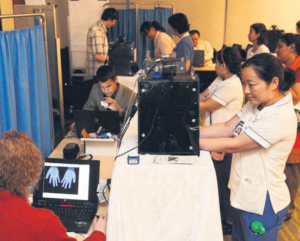In our previous post, we described what the fluorescent method is, and how to apply it to examine hand hygiene technique. Now, we will present some of the good practices, settings, where the fluorescent method should be applied.
At the Medical Faculty of the University of Debrecen (Hungary), the fluorescent method was applied to test the effectiveness of surgical hand rub technique. In the 2013/2014 academic year, 285 third-year medical students were involved in a survey; surgical and rubbing technique were investigated twice with the fluorescence method during the semester. The most common insufficiently disinfected areas were thumbs and fingertips. The number of students with unsatisfactory surgical hand disinfection was significantly lower in the second survey. Identifying students who failed to perform provided the tutor the opportunity to pay special care and attention to those, and help them to correct their technique [1].
At the Medical Faculty of the Technical University Dresden (Germany), the fluorescent method was used to determine the effect of a standardized training. 4th year medical students were randomly assigned into two groups, an interventional and a control group. The interventional group attended a 45-minute lecture about practical competences, including hand rubbing according to the EN 1500 standard. The interventional group showed significantly better results in hand hygiene when tested with the fluorescent method [2].
In another study in Philadelphia, PA (USA), the fluorescent method was applied during a simulation training of urinary tract catheterization. Medical students completed an anonymous survey after the study. Most of them claimed that ‘this educational intervention enhanced their learning better than traditional lectures and reading alone’ and that ‘they would now pay extra attention while washing their hands’ [3].
At the Semmelweis University (Hungary), testing the hand hygiene technique with the fluorescent method has been part of the Basic Surgical Techniques class offered for third-year medical students since 2011. In the last couple of years, they started to use the Semmelweis Scanner to make the feedback more objective [4]. The method was then developed into a national campaign (Figure 1).

Figure 1: Hand hygiene training and presentation in a Hungarian hospital.
At the National Taiwan University Hospital, 388 health-care workers voluntary participated a study examining proper hand hygiene technique with the fluorescent method. The highest percentage of residue points was under the tips of the nails, followed by the fingertips [5].
The National University Hospital (NUH) of Singapore is a 1000-bed tertiary center. They pay special attention to hand hygiene. In 2011, within the frames of WHO Save Lives: Clean Your Hands campaign, a hand hygiene education and assessment program was organized, targeted 5200 clinical staff over 7 days. Instructors trained participants in small group about the correct technique of hand hygiene (Figure 2). Fluorescent measurement happened immediately after that, even so only 72% of staff achieved satisfactory hand coverage. Nurses performed best, and women performed better than men [6].

Figure 2: Hand hygiene education and assessment program in National University Hospital (NUH) of Singapore, 2011. Fluorescent images were recorded by the prototype of Semmelweis Scanner.
Conclusion:
The fluorescent method is applied worldwide in medical universities and hospitals, since it is a great educational tool. Automation of the fluorescent method will let it become even more popular.
Read our previous post on the fluorescent method. Please stand by for our next blog entry on the microbiological evaluation of the fluorescent method.